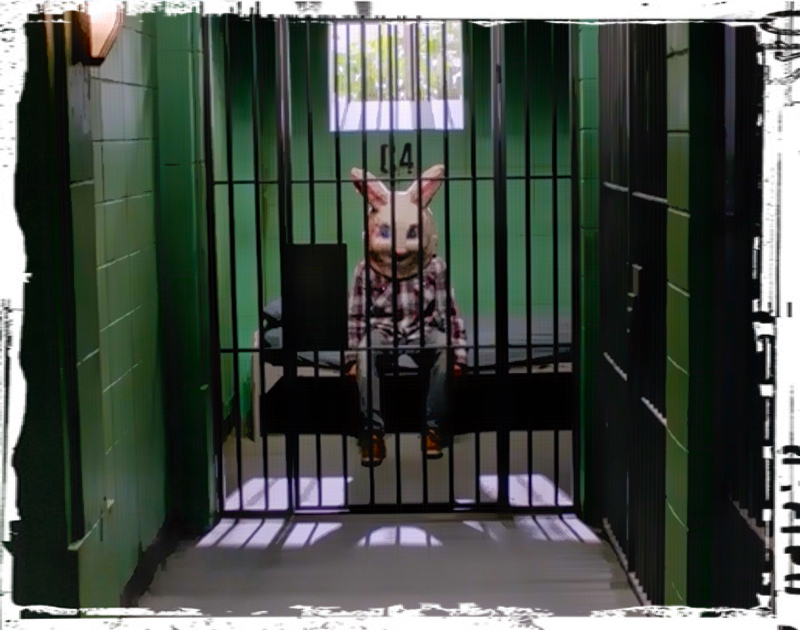
https://thesupernaturalfoxsisters.com/2015/11/20/supernatural-s11e07-recap-plush/bunny-in-jail-supernatural-plush/
Somewhere along the line (God only knows when), people decided that the Easter Bunny is evil.
History Channel and its ilk (i.e. Discovery Channel, the Internet) started preaching a while back that the Easter Bunny was some kind of pagan demon-rabbit left over from the pre-Christian days.
Then, Evangelical Protestants pretty quickly jumped on the bandwagon, choosing to throw the Easter Bunny and his festive eggs on the (sometimes) proverbial evil-burnin’ fire along with Harry Potter books and joy.
But here’s the thing: whenever you see History Channel and Protestants uniting to say something’s pagan, it’s usually a pretty good tipoff that said-something actually has deeply Catholic roots. This rule holds true for Santa, Christmas trees, Halloween, Valentine’s Day, and especially the Easter Bunny.
Before we get to the Easter Bunny’s origins story, however, let’s take a moment to debunk the popular argument for his paganism.
The trouble pretty much starts and ends with a 19th century piece on the origins of Easter customs written by Jakob Grimm (yeah, the fairytale guy). In his writings, Grimm mentions an ancient Germanic fertility goddess known as Ostara who returned every Spring bringing rabbits and general sexiness. He cited this goddess as the origins of the Easter Bunny, Easter eggs, and other fun stuff like that.
The problem with this theory is that Grimm was literally the only person to ever document any such custom. In fact, the mention of Ostara is almost a throw-away comment, making up no more than one sentence in his writings. This, coupled with the fact that Grimm was strongly anti-Catholic, means that using his writings as an argument for the Easter Bunny’s pagan origins is flimsy at best.
So what are the Catholic origins of the Easter Bunny?
Our story starts with crappy science. See, despite the fact that the Catholic Church pretty much invented science, the Middle Ages still put out some truly bizarre hypotheses regarding the natural world. Many of these animal “facts” were then picked up by clergy and religious artists to make theological points. For instance, the observation of the bizarre way a pelican feeds its young (vomit soup, anyone?) led medieval scientists to conclude that pelicans fed pieces of their own body to their babies. The Church then picked this up and rolled with it, using the pelican as a Eucharistic parallel in everything from paintings to stained-glass windows.
Now, as we all know, rabbits have a tendency to multiply like… well, rabbits. Today, we recognize that this is due to insane levels of copulation, but in the middle ages they blamed parthenogenesis. Unable to fathom any species that would mate that much, medieval scholars concluded that female rabbits could conceive without the necessity of males. Rabbits began to be associated with purity and perpetual virginity, white rabbits even more so.
Soon they were being used as symbols of the Virgin Mary, as seen in Titian’s Madonna of the Rabbit. Like Mary, therefore, the rabbit was seen in art as a herald for Christ, preparing the way for the Savior and pointing back to Him. This is especially interesting when one considers the fact that the Easter Bunny is traditionally held to visit on the eve of Easter (not Easter Sunday), heralding the resurrection on the following day.
The rabbit’s popularity only grew over the years, due both to its Marian identity in art and at least one major Eucharistic miracle associated with the animal (you can read all about how rabbits protected consecrated hosts from the elements here).
Pretty soon, the animal’s tendency to be viewed as a herald of Christ got it included in Easter festivities around Europe. It also wasn’t long before rabbits got lumped in with the popular European emphasis on eggs which were used to represent the tomb (dying eggs originates from when Catholics were not allowed to eat eggs during Lent. Rather than throw them away, Christians would pickle their eggs, coloring them any number of shades depending on the pickling method utilized. Hence, colored eggs in particular became associated with Easter).
Rabbits and, by extension, their association with Easter eggs became so popular that, in 1682 when Archbishop Georg Franck von Frankenau published his dissertation De ovis paschalibus (About Easter Eggs), he saw fit to include the French tradition of a hare bringing the colorful treats.
Eventually, as with most folksy holiday customs, Catholic immigrants brought the “Easter Hare” (or “Osterhase”) to America.
So there it is: The Easter Bunnies true (and distinctively Catholic) origins story. And if you’ve lived most of your life believing that Mr. Osterhase was pagan, it’s not too late! Go out, dye some eggs, buy yourself a candy bar, and make sure to pass along the truth behind this proud Catholic tradition.
http://theholyfool.blogspot.com/2013/03/the-truth-about-easter-bunny.html

Image by kalhh from Pixabay

